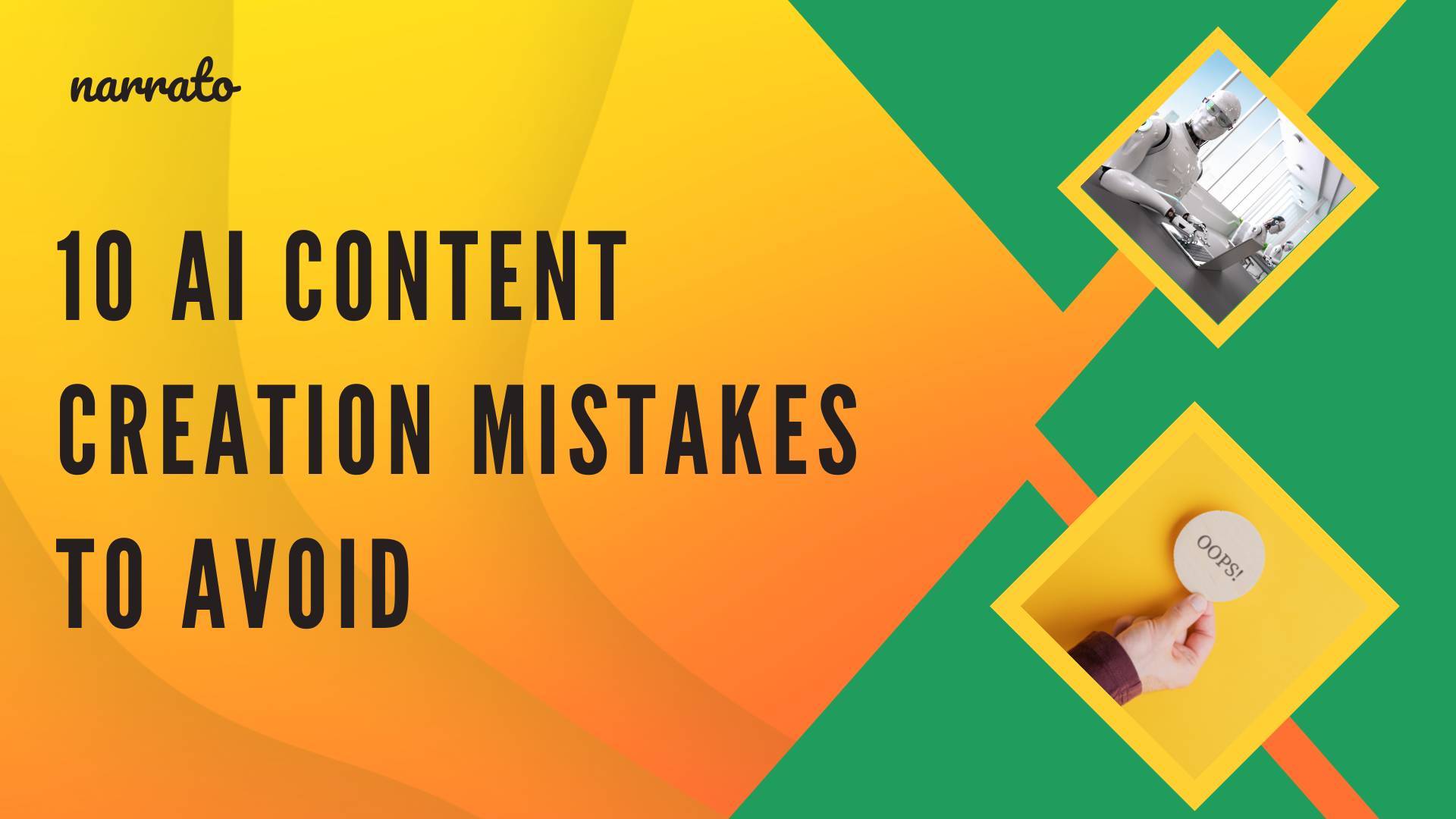AI content creation is a blessing for creators and marketers. Especially now that machine learning capabilities are seeing new highs with tools like ChatGPT. AI content creation tools are changing the way we carry out content research and creation. But this content marketing boon could quickly turn sour if you’re not careful in avoiding some common but often overlooked blunders. Despite how AI is augmenting productivity in content creation, it is easy to misuse the tool and end up derailing your content strategy instead of streamlining it.
In this article, we’re looking at 10 common AI content creation mistakes that could cost you search rankings and conversions in the long run. We’ll also talk about how you can dodge these bullets to make AI content creation work in your favor. Without much ado, let’s dive right into it.
TL;DR Here’s a quick summary video of this article.
- Relying entirely on AI content creation without human input or oversight
- Creating entire articles or other long-form content with an AI content creator
- Not focusing on the audience and target market in AI content creation
- Ignoring branding and tone of voice, leading to inconsistent and generic content
- Using AI content creation for writing in styles or topics not suitable for the technology
- Over-optimizing AI content for search engines and compromising on quality
- Neglecting legal and ethical considerations
- Not properly evaluating the quality of AI-generated content
- Ignoring context and cultural sensitivity in AI content creation
- Not experimenting with multiple variations of the AI content output

10 AI content creation mistakes to avoid
While we’re always advocating the use of AI in content creation, telling you how to leverage it in your content creation process, it is also important to caution you about what could go wrong if you don’t use these tools correctly. So here are some important dos and don’ts of AI-powered content creation.
1. Relying entirely on AI content creation without human input or oversight
Yes, AI content creation tools are supposed to minimize your workload and in a perfect world, AI-generated content should not need any human oversight. But we live in a world where nothing is perfect (yet!) so relying solely on AI and machine learning to create content for your audience is a blunder. Using your discretion and human intellect, even when using AI-generated content is imperative. Generating entire articles with AI also makes your content more likely to be flagged by AI content detectors.
Why does AI-driven content creation need human oversight? Because no matter how intelligent it gets, an AI tool is not human. AI tools for content creation may not always capture the essence or emotions you want to convey, and the content may end up looking and sounding robotic. This especially happens if your AI content creator does not let you customize for tone and context. Or the inputs provided are not apt. Keeping a tab on AI-based content creation will give you better control over the process and help you improve your inputs to generate more accurate outputs.
AI-generated content also requires fact-checking. Though these tools are trained on tons of data available to them on the world wide web, there could be occasional inaccuracies as some of the source material itself could be factually incorrect. Having human oversight ensures that the content you are putting out is free of any such errors.
2. Creating entire articles or other long-form content with an AI content creator
This is a major content marketing mistake. Though AI tools for content creation are getting better and better at creating natural, conversational pieces, they’re not meant for writing entire articles yet. AI tools cannot always maintain the flow of thoughts or stitch sentences and paragraphs together as a human writer can. This is where the emotional intelligence and creativity of humans come into play, and it is non-replicable for AI.
Yes, generating entire long-form pieces using AI for content creation could save you hours of work. But in trying to ramp up the quantity with automation, you would be compromising on quality. AI content creation tools are great for generating short-form content like social media posts, blog post intros, product descriptions, video descriptions, etc. They’re great at improving and paraphrasing parts of your content too. But when it comes to writing long-form content, using AI all the way can make it look incoherent or repetitive.
AI writing assistants are meant to make your job easier, but not to do your job for you. Even if you choose to create all your content with AI, your audience will most likely see through it. You also risk losing your creativity and skill if you make AI writers do all the work.
3. Not focusing on the audience and target market in AI content creation
Even when creating content with an AI writer, keeping your audience and target market in mind is crucial. Every content marketing campaign has an ideal customer profile or a target audience persona which dictates how your content should be written. For instance, if your target market is C-suite executives, you may need content that is more technical and in-depth. If your audience is the general public, your language has to be simple and free of industry jargon.
Make sure to use an AI writing tool that takes care of this. Narrato’s AI writer, for instance, requires you to specify your audience along with your input to generate relevant content.
Here’s an example.
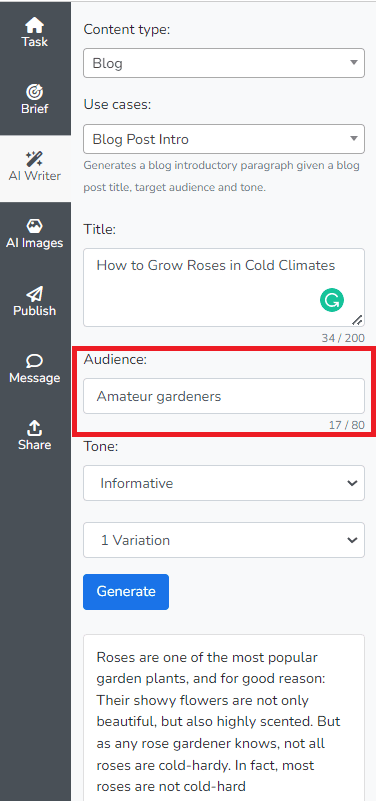
If your AI-driven content creation tool does not offer this capability, it is high time to reconsider your choice. Not paying attention to the target audience and market means your AI content will not hit the right chords with the right people. Your content instantly loses its personality and appeal, and you lose your chance to connect with the audience.
4. Ignoring branding and tone of voice, leading to inconsistent and generic content
Another big mistake in AI content creation is not optimizing for the tone of voice and not being consistent with your branding. If your content does not pay attention to these crucial factors, it will end up looking inconsistent and carelessly put together.
It is important that your entire content piece has the same tone of voice and offers the same consistent experience to a reader. Narrato’s AI writing assistant has ‘tone’ as a mandatory prerequisite for generating content. You can choose your tone from a long dropdown list to match the tone and context of the rest of your content.
Here’s an example. We first generated a blog post conclusion with the tone set as ‘Enthusiastic’.
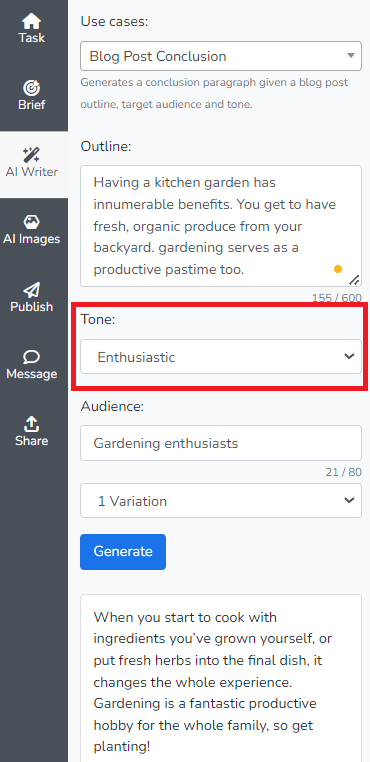
We then set it to ‘Grumpy’, and you can see how the output changed.
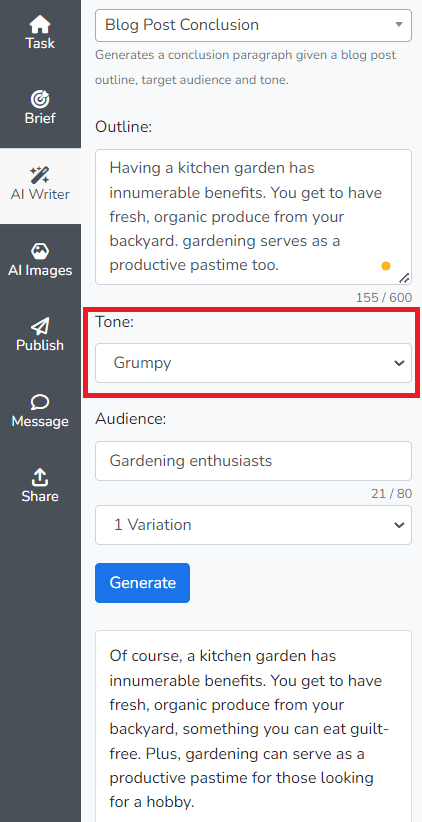
If your AI blog writer does not take the tone of voice into consideration, it is probably not the ideal choice.
Also, make sure to include any brand-specific keywords or your brand name in the input text if you are creating branded content. Unless you provide the AI content creation tool with the right input that captures your branding requirements, it is not possible to generate branded content. As a result, your content will be generic and fail to build a distinct brand identity for you. This is particularly important for website copy, product description, and other such use cases.
It is important to have a brand style guide that defines what your content should look like. You can save your content style guides in Narrato’s style guides library and attach them to your content tasks. This makes it easier to compare the AI-generated content to the guidelines, than having to toggle between different browser tabs or windows.
5. Using AI content creation for writing in styles or topics not suitable for the technology
AI content creation is constantly evolving to become a more powerful tool for content marketing, but it still has its limitations. While it can be great for creating, short, crisp blurbs and writeups, it cannot do justice to more complex content types. Content that is too nuanced or abstract, thought-leadership content, etc. is not its forte. You must understand that AI algorithms cannot generate new concepts or create impactful thought-leadership pieces as they are trained on existing data.
If you are looking to propagate an original idea, write about an original scientific finding, create something deeply thought-provoking or emotional, etc. then your AI content tool is likely to fail at it. AI-based content creation does not work well for highly creative writing, understanding cultural references/subtleties in your content, or complex technical writing. Using AI-powered content creation where its hands are tied can result in unimaginative, insensitive, or technically incorrect outputs.
So make sure that you understand the scope and limitations of AI-driven content creation before you start.
6. Over-optimizing AI content for search engines and compromising on quality
With automation in content creation, it is possible to over-optimize the content for search. AI tools are good at these rule-based activities and if you are not careful or rely too much on the AI content tool, you could end up with keyword-stuffed, over-optimized content. This does nothing for the audience. And though it seems like search engines would love this, that’s not true either. If your content is not valuable to the audience and is simply stuffed with keywords disrupting the natural flow, Google could penalize you for this content marketing mistake too.
This is where ensuring content quality and the optimum use of SEO essentials is important. The best way to approach this would be to generate an SEO content brief on Narrato. The SEO content brief gives you keyword suggestions along with counts, among other things. So you can ensure that your content is not over or under-optimized and all keywords have been used the recommended number of times.
Here’s how the keywords on the brief change color to indicate whether you’ve used them enough. The keyword counts automatically update as well.
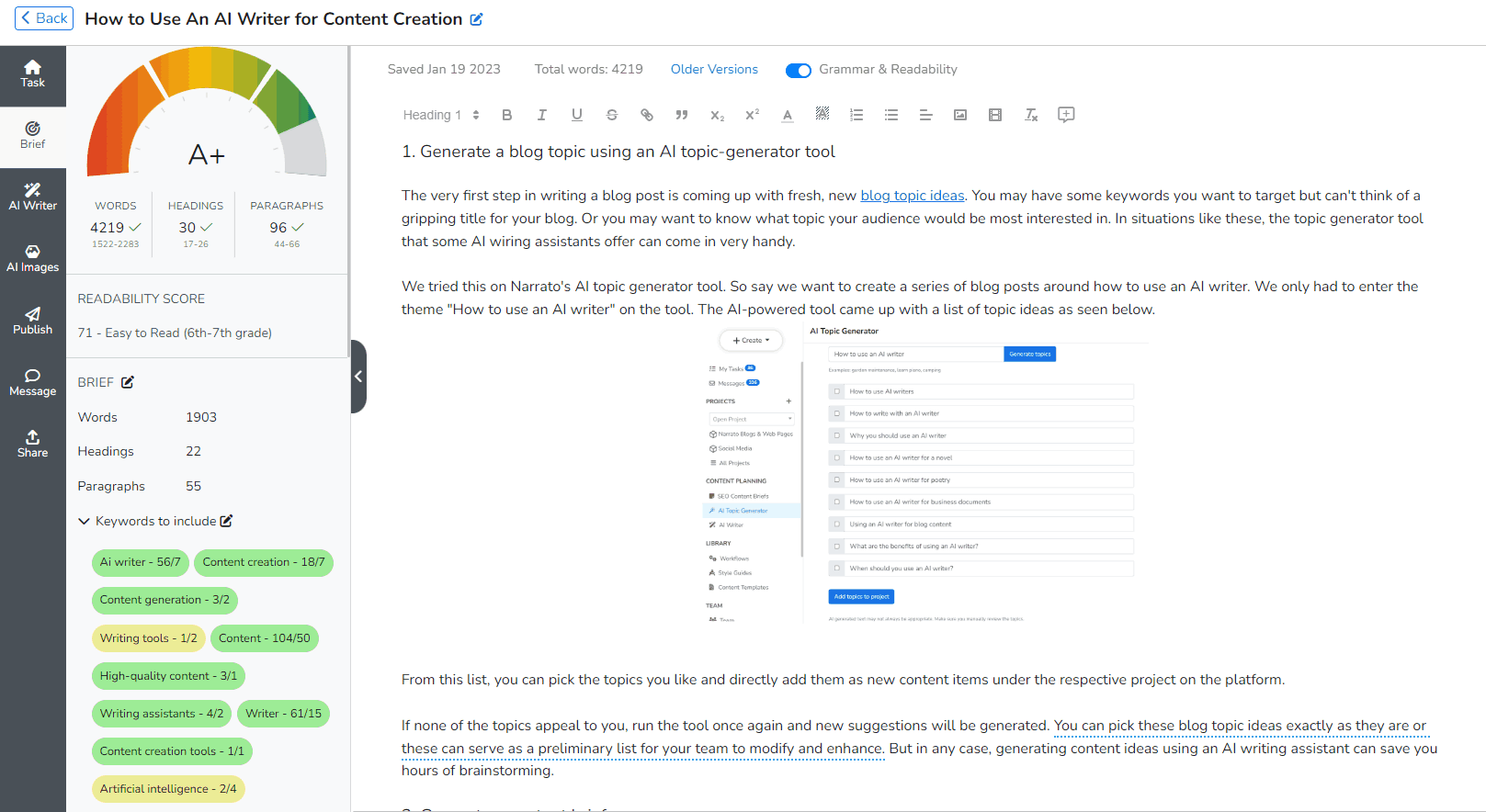
Make sure that your AI-generated content is written for humans and not just for search engines. It should have keywords fitting in it naturally and not look forced. Focus more on the content’s quality than on its ranking capability. If your audience finds your content useful and spends more time on it, links out to it, or shares it with their circle, your chances of ranking will increase anyway.

7. Neglecting legal and ethical considerations
In content marketing, like any other area of business, complying with certain legal and ethical standards is extremely important. Neglecting these considerations can not only cause your search rankings to drop but may result in far more severe consequences.
Issues like copyright infringement, plagiarism, use of biased data, data privacy breach, or misinformation can cause harm to others and to your business alike. AI content creation tools are trained on data and it is possible for this data to be biased or false. They could also pull content, images, etc. that are protected by intellectual property rights. This is why it is important to use a reliable AI content tool that provides you with only original and no-attribution required content.
Plagiarised content could instantly bring your search rankings down. So make sure to run your AI-generated content through a plagiarism checker tool before publishing it. If you’re creating content on Narrato, you already have access to a plagiarism checker and can run checks on all your AI-generated content instantly without leaving the platform.
Narrato also offers a free image search tool where you can find thousands of royalty-free, no-attribution images and don’t have to worry about obtaining any permissions or licenses.
8. Not properly evaluating the quality of AI-generated content
In trying to produce content faster with automation and AI tools, users may neglect content quality. In the long run, however, this could have a serious impact on your blog or website’s authority and your brand image too. Not evaluating content quality before publishing is one of the gravest content marketing mistakes but addressing this issue is not as tough as you may think.
If you are using Narrato’s AI writer and content editor, you automatically get alerts on content quality issues. The AI content assistant on the platform gives you content improvement suggestions, highlighting excessively long sentences and paragraphs, excessive use of passive voice, etc. It also has a grammar checker tool that highlights spelling and grammatical errors.
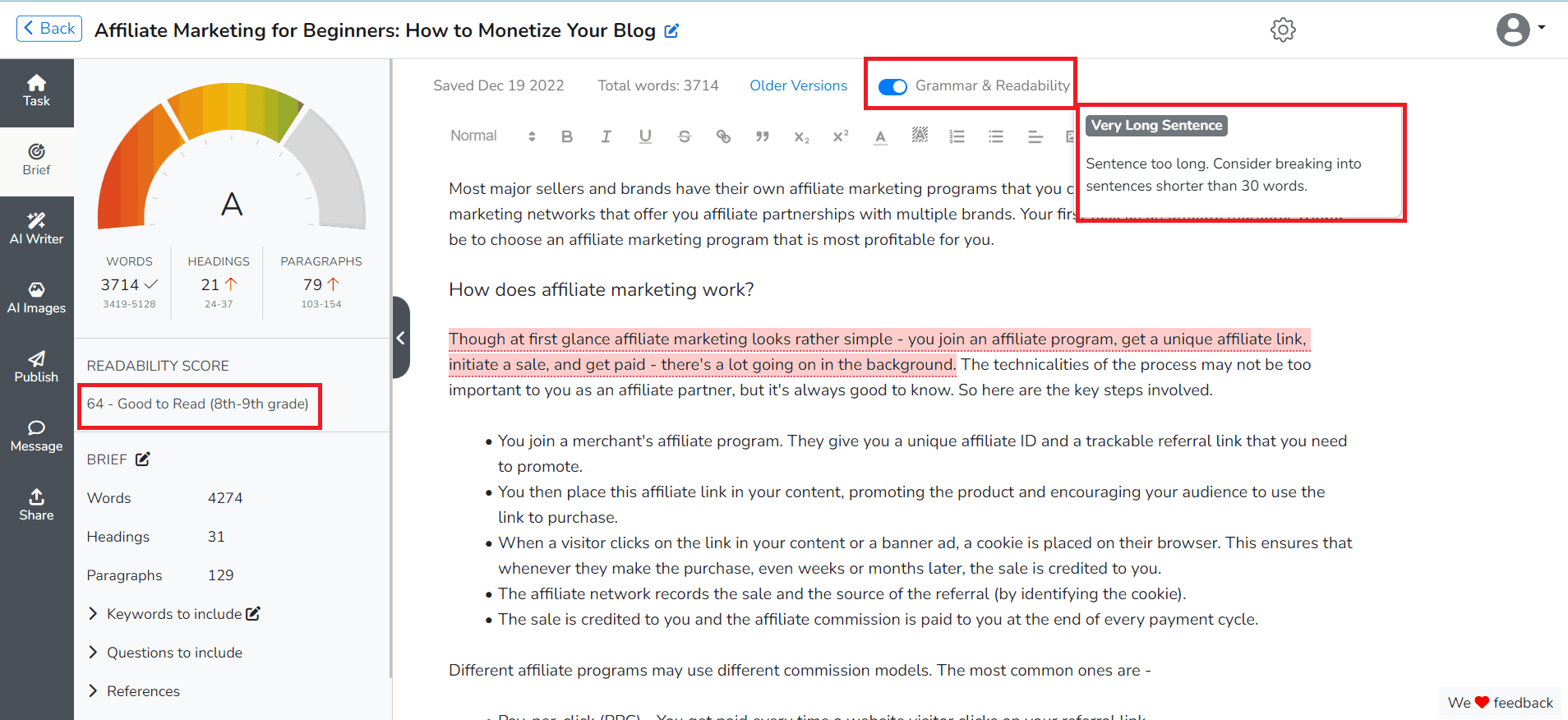
Make sure to run your AI content through a tool like this to make proofreading and editing easier. You can also use Narrato AI writer’s ‘Content Improver’ or ‘Paraphrasing’ use case to improve your sentences and paragraphs where necessary.
9. Ignoring context and cultural sensitivity in AI content creation
Diversity, equity, and inclusion are core principles of marketing today that you cannot simply ignore. With AI-based content creation, however, it is easy to overlook these considerations. The content generated by an AI tool may not always represent diversity or be culturally sensitive if it is not trained on diverse data. It could also get the context wrong if your input text is flawed.
Reviewing the content to make sure that it does not show any kind of cultural, racial, or gender bias, and does not hurt the sentiments of any particular group is essential. You also need to be cautious that the tool does not take your text input out of context and generate something that could be bad for your brand reputation. That is why providing descriptive, clear, and contextual inputs in AI-powered content creation is imperative.
Proofread and double-check your AI-generated text.
10. Not experimenting with multiple variations of the AI content output
Most AI content creation tools let you generate multiple variations of the AI content output for the same set of inputs. Not using this to your advantage can be a big mistake. Tools like Narrato’s AI writing assistant even let you generate up to three variations of the output in one go. You can choose the one you like most and add it to your editor. Or if you want something different keep generating until you’ve found your pick.
Experiment with multiple variations to find the best version. It could actually take you lesser time than settling for the very first output you get and then trying to optimize it.
Wrapping up
Avoid these common AI content creation mistakes, and you’ll see how the right AI tools can take your content to the next level. You’ll also see how they can make your content process more efficient, saving you time and boosting productivity. AI content tools are your allies in the content creation process, but they need human oversight. A little bit of care when using AI in content creation can go a long way in improving content quality and speeding up content production.


